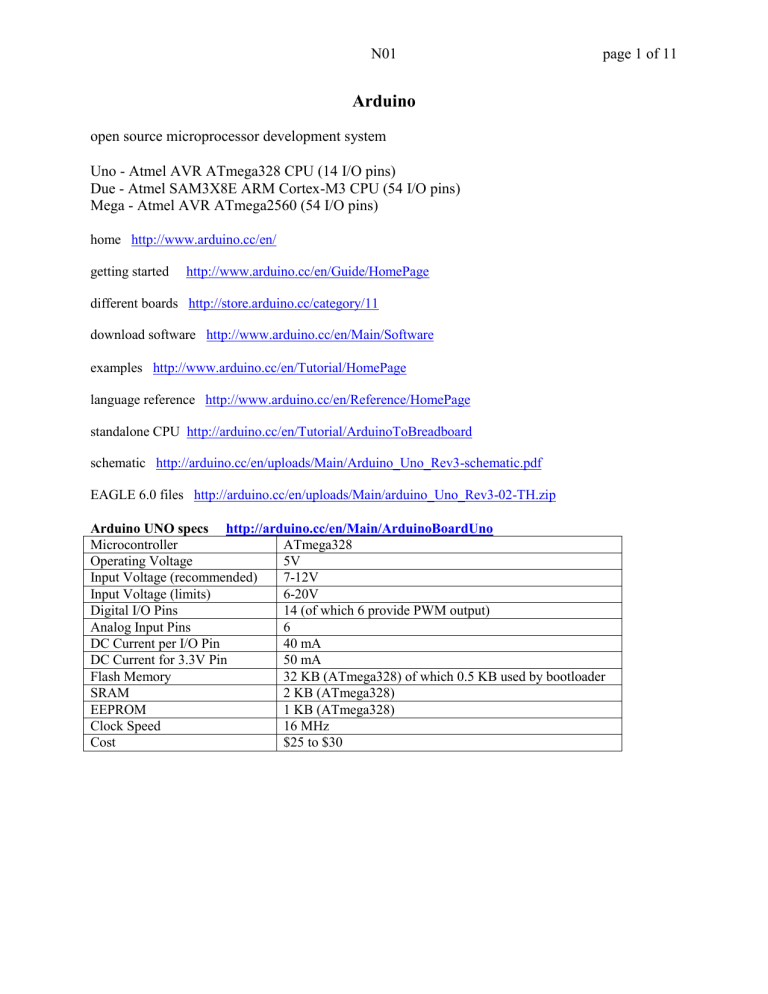N01

N01 page 1 of 11
Arduino
open source microprocessor development system
Uno - Atmel AVR ATmega328 CPU (14 I/O pins)
Due - Atmel SAM3X8E ARM Cortex-M3 CPU (54 I/O pins)
Mega - Atmel AVR ATmega2560 (54 I/O pins) home http://www.arduino.cc/en/ getting started http://www.arduino.cc/en/Guide/HomePage different boards http://store.arduino.cc/category/11 download software http://www.arduino.cc/en/Main/Software examples http://www.arduino.cc/en/Tutorial/HomePage language reference http://www.arduino.cc/en/Reference/HomePage standalone CPU http://arduino.cc/en/Tutorial/ArduinoToBreadboard schematic http://arduino.cc/en/uploads/Main/Arduino_Uno_Rev3-schematic.pdf
EAGLE 6.0 files http://arduino.cc/en/uploads/Main/arduino_Uno_Rev3-02-TH.zip
Arduino UNO specs http://arduino.cc/en/Main/ArduinoBoardUno
Microcontroller ATmega328
Operating Voltage 5V
Input Voltage (recommended) 7-12V
Input Voltage (limits)
Digital I/O Pins
6-20V
14 (of which 6 provide PWM output)
Analog Input Pins
DC Current per I/O Pin
DC Current for 3.3V Pin
Flash Memory
SRAM
EEPROM
Clock Speed
Cost
6
40 mA
50 mA
32 KB (ATmega328) of which 0.5 KB used by bootloader
2 KB (ATmega328)
1 KB (ATmega328)
16 MHz
$25 to $30
N01 page 2 of 11
Arduino Datatypes (Variables)
progams are called "sketches" strongly typed programming language based on "Wiring" - very similar to C
MATLAB generally uses 64b floating point variables and does not require explicit declaration must declare variables for Arduino bit values 0 = low = off = false = space 1= high = on = true = mark
8 bits = 1 byte
4 bits = 1 nibble
8b = 1B each byte has an upper and lower nibble http://www.arduino.cc/en/Reference/HomePage boolean logic 8b 0 = false or 1 = true char char byte int character 8b integer 8b signed integer integer
8b
16b unsigned signed
ASCII
-128 to 127
0 to 255
-32,768 to 32,767 unsigned int integer long integer
16b unsigned 0 to 65,535
32b signed -2,147,483,648 to 2,147,483,647 unsigned long float double string integer float float character
32b unsigned 0 to 4,294,967,295
32b signed single precision ±3.4x10
38
(7 decimal digits)
64b signed double precision ±1.8x10
308
(15 decimal digits)
ASCII array
// examples boolean a, b = false; // logical char c, d = “Q”; // character char e, f = -17; // 8b signed byte g, h = 5; // 8b unsigned int i, j = -3; // 16b signed --- most common unsigned int k, l = 5; // 16b unsigned long m, n = -3; // 32b signed unsigned long o, p = 5; // 32b unsigned float q, r = 7.5; // single precision float double s, t = -9.7; // double precision float char u[] = “Arduino”; // 7 chars plus 1 end-of-string null char char v[8] = “Arduino”; // same as above int w[9], x[4] = { 7, 9, -3, 85 }; // array of int variables – uses 0 for first index
N01
ASCII Table
page 3 of 11
N01 page 4 of 11
Number Systems
Decimal base 10 - radix 10 ten numerals 0 1 2 3 4 5 6 7 8 9
10
2
10
1
10
0
10
-1
10
-2
367.29 =
3 6 7 . 2 9
Binary base 2 hundreds tens ones radix point tenths hundredths two numerals 0 1
2
7
2
6
2
5
2
4
2
3
2
2
2
1
2
0
0101 0110 =
0 1 0 1 0 1 1 0
= 86 decimal
128 64 32 16 8 4 2 1
2 7 2 6 2 5 2 4 2 3 2 2 2 1 2 0
0100 1001 =
0 1 0 0 1 0 0 1
= 73 decimal
128 64 32 16 8 4 2 1
2
3
2
2
2
1
2
0
2
-1
2
-2
2
-3
2
-4
0111.0101 =
0 1 1 1 . 0 1 0 1
= 7 5/16 dec
8 4 2 1 1/2 1/4 1/8 1/16
N01
Hexadecimal base 16 sixteen numerals 0 1 2 3 4 5 6 7 8 9 A B C D E F
10 11 12 13 14 15
16
2
16
1
16
0
3B7 hex =
3 B 7
= 3 * 256 + 11 * 16 + 7 * 1 = 951 decimal
256 16 1
3B7 hex =
3 B 7
0011 1011 0111 binary
Addition
0011 0101 binary
+ 0001 1001
0100 1110
Multiplication
0 0 1 1 x 0 1 0 1
0 0 1 1
0 0 0 0
0 0 1 1
0 0 0 0
0 0 0 1 1 1 1
53 dec
25
78
3 x 5
15
35 hex
19
4E page 5 of 11
N01
Sign Convention
Mark sign most significant bit (msb) contains sign and remaining bits are absolute value
0 = positive, 1 = negative unfortunately does not conform to arithmetic
0000 1001 = +9 dec using mark sign
1000 0011 = -3 dec using mark sign sum 1000 1100 = -12 dec using mark sign
Offset sign (biased) smallest integer is most negative number largest integer is most positive number example using -127 offset (bias)
0000 0000 = -127 dec
0111 1111 = 0 dec
1000 0000 = 1 dec
1111 1111 = 128 dec unfortunately does not conform to arithmetic
1000 1000 = +9 dec using -127 offset
0111 1100 = -3 dec using -127 offset sum 0000 0100 = -123 dec using -127 offset often used for bipolar analog-to-digital converters (ADC) example using 12b ADC for ±10V range
0000 0000 0000 = -10V
0111 1111 1111 = 0 V
1111 1111 1111 = +10V page 6 of 11
N01
Two’s complement standard method used to store all signed integers step one step two invert all bits add one
0000 0011 = +3 dec using two’s complement invert all bits 1111 1100 add one 1111 1101 = -3 dec using two’s complement msb indicates sign but remaining bits are not absolute value like mark sign conforms to arithmetic
0000 1001 = +9 dec using two’s complement
1111 1101 = -3 dec using two’s complement sum 0000 0110 = +6 dec using two’s complement negation is reversible
1111 1101 = -3 dec using two’s complement invert all bits 0000 0010 add one 0000 0011 = +3 dec using two’s complement page 7 of 11
N01
Floating Point
IEEE 754-2008 includes special forms for zero, +∞, -∞ and NaN
Single precision – 7 decimal digits of precision mark sign in msb
8b exponent power of 2 with -127 offset sign binary fraction
0 01111100 00100000000000000000000 =
(−1) 0
× (1 + 0.25) × 2
(124–127)
= 1.25 × 2
−3
= 0.15625
1 01111101 00101100000000000000000 =
(−1) 1 × (1 + 0.34375) × 2 (125–127) = -1.34375× 2
−2
= -0.3359375
Double precision – 15 decimal digits of precision page 8 of 11
N01 page 9 of 11
Arduino prgramming language compiled language very similar to C can communicate back to PC through serial port monitor using Serial functions must use semi-colon at end of each line (except #define and #include) variable names are case sensitive - "Mmm" not same as "mmm" variables are local to functions unless declared in intial global block
// remainder of line is comment
/* block of lines comment */
// permanent constants - global text substitution used during compilation
// NO SEMI-COLON AT END !
#define M1_enable 6
// insert large block of text from file during compiliation
// NO SEMI-COLON AT END !
#include <avr/pgmspace.h>
// integer constants a1 = 137; // decimal a2 = B11011; // binary - leading "B" a3 = 0x7B; // hex - leading "0x"
Sections of Code
1) initial block for #define, #include and global variables
2) void setup() { // code executed once }
3) void loop() { // infinite loop }
4) subroutines
N01
// stepper - one stepping motor
// HJSIII, 14.01.13
////////////////////////////////////////////////////////////
// define pin names
// wire colors for Oriental Vexta
#define coilA 2 // black
#define coilB 3 // blue
#define coilC 4 // green
#define coilD 5 // red
// yellow AC common
// white BD common
// declare global variables int row; // 16b signed byte abcd; // 8b unsigned byte table[8] = { 8, 4, 2, 1, 8, 4, 2, 1 }; // wave drive
//byte table[8] = { 9, 12, 6, 3, 9, 12, 6, 3 }; // two phase
//byte table[8] = { 8, 12, 4, 6, 2, 3, 1, 9 }; // half step
////////////////////////////////////////////////////////////
// setup routine runs once when you press reset void setup() {
// initialize serial communication at 9600 bits per second:
Serial.begin(9600);
// configure digital outputs
pinMode( coilA, OUTPUT );
pinMode( coilB, OUTPUT );
pinMode( coilC, OUTPUT );
pinMode( coilD, OUTPUT );
// send intial position
row = 0;
abcd = table[ row ];
digitalWrite( coilA, bitRead( abcd, 3 ) );
digitalWrite( coilB, bitRead( abcd, 2 ) );
digitalWrite( coilC, bitRead( abcd, 1 ) );
digitalWrite( coilD, bitRead( abcd, 0 ) );
}
// bottom of setup
////////////////////////////////////////////////////////////
// infinite loop void loop() {
// declare local variables
int nStep, delayStep; // 16b signed
// length of delay [sec]
// Vexta, ULN2803A, 5V breadboard supply, no load
// 35 msec single step, 25 msec two phase, 35 msec half step
delayStep = 35;
// move
Serial.println( "Forward" ); page 10 of 11
N01
nStep = 200;
moveStep( nStep, delayStep );
delay( 1000 );
Serial.println( "Back" );
nStep = -200;
moveStep( nStep, delayStep );
delay( 1000 );
}
////////////////////////////////////////////////////////////
// function to index through stepper table
// INPUTS
// nStep = signed number of steps
// positive moves down through table
// negative moves up through table
// delayStep = delay between steps [msec]
// OUTPUTS
// none void moveStep( int nStep, int delayStep ){
// declare local variables
int i, n, dir; // 16b signed
// number of steps and direction
n = abs( nStep );
dir = constrain( nStep, -1, 1 );
// count steps
if( n > 0 ){
for( i=0; i<n; i++ ){
// next row in table
row = row + dir;
if( row < 0 ){ row = 7; }
if( row > 7 ){ row = 0; }
// send new position
abcd = table[ row ];
digitalWrite( coilA, bitRead( abcd, 3 ) );
digitalWrite( coilB, bitRead( abcd, 2 ) );
digitalWrite( coilC, bitRead( abcd, 1 ) );
digitalWrite( coilD, bitRead( abcd, 0 ) );
Serial.println(abcd); // show time
// delay
delay( delayStep );
} // bottom of for
} // bottom of if
} // bottom of moveStep
////////////////////////////////////////////////////////////
// bottom of stepper page 11 of 11





